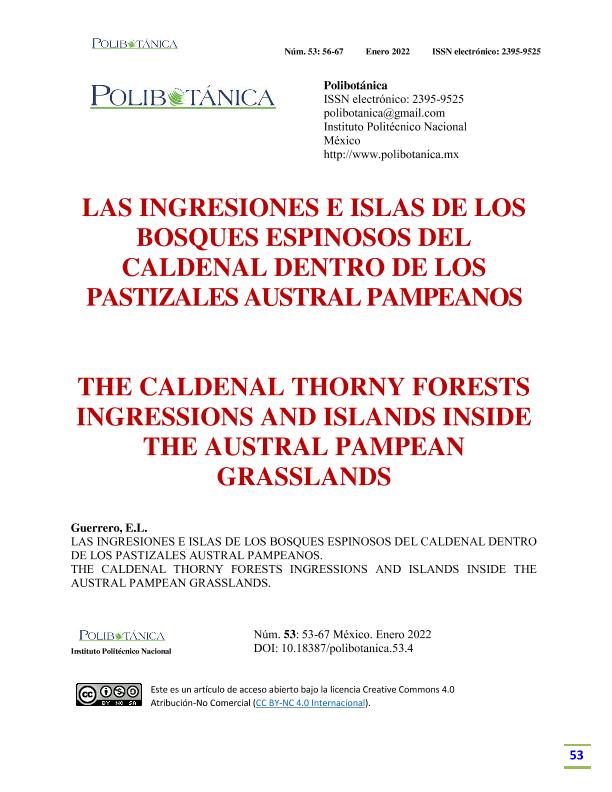Mostrar el registro sencillo del ítem
dc.contributor.author
Guerrero, Elián Leandro

dc.date.available
2023-02-15T14:21:47Z
dc.date.issued
2022-02
dc.identifier.citation
Guerrero, Elián Leandro; Las ingresiones e islas de los bosques espinosos del Caldenal dentro de los pastizales Austral Pampeanos; Instituto Politécnico Nacional; Polibotánica; 53; 2-2022; 56-67
dc.identifier.uri
http://hdl.handle.net/11336/188099
dc.description.abstract
El sector sur del Espinal está conformado por bosques de Prosopiscaldenia, una especie endémica de este sector que se conoce comúnmente como Caldén.Los bosques de esta especie, o Caldenales, contactan al este con los pastizalesPampeanos, pero el límite entre estas dos unidades varía según los mapas de distintosautores. Se estudió el sector sur de este límite confuso, en donde pequeños parches devegetación leñosa se intercalan en una matriz de pastizales. Se evaluó si esos parchesinmersos en las Pampas deberían ser mapeados como parte del Caldenal. Con eseobjetivo se recopiló la bibliografía correspondiente, se examinaron materiales deherbario, bases de datos, cartografía y se realizaron viajes de campo. Se estudió lavegetación de un sitio localizado en Sierra de la Ventana en detalle. Los parches devegetación espinosa del suroeste de Buenos Aires están conformados por unsubconjunto de las plantas que componen los bosques y matorrales del Caldenal. Por lotanto, se plantea que estas asociaciones deberían ser clasificadas dentro del Caldenal. Laimportancia de identificar, clasificar y mapear estas islas de vegetación supera el interésacadémico o de investigación y puede ser útil para la legislación argentina para laconservación de la biodiversidad.
dc.description.abstract
The southern sector of Espinal is made up of Prosopis caldenia forests, an endemic species of this sector that is commonly known as Caldén. The forests of this species, or Caldenales, contact the Pampean grasslands to the east, but the boundary between these two units varies according to the maps of different authors. The southern sector of this confusing boundary was studied, where small patches of woody vegetation are interspersed in a grassland matrix. It was evaluated whether those patches immersed in the Pampas should be mapped as part of the Caldenal. With that aim, the corresponding bibliography was compiled, herbarium materials, databases, cartography were examined, and field trips were made. The vegetation in a site placed in Sierra de la Ventana was studied in detail. The thorny vegetation patches of the southwest of Buenos Aires are made up of a subset of the Caldenal forests and scrublands plants. Therefore, it is proposed that these associations should be classified within the Caldenal. The importance of identifying, classifying, and mapping these vegetation islands surpasses the academic or research interest and may be useful to the Argentinean biodiversity conservation national laws.
dc.format
application/pdf
dc.language.iso
spa
dc.publisher
Instituto Politécnico Nacional
dc.rights
info:eu-repo/semantics/openAccess
dc.rights.uri
https://creativecommons.org/licenses/by-nc-sa/2.5/ar/
dc.subject
CALDENAL
dc.subject
PAMPA
dc.subject
SIERRA DE LA VENTANA
dc.subject
FITOGEOGRAFÍA
dc.subject
ÁREA DE ENDEMISMO
dc.subject
CONSERVACIÓN DE LA BIODIVERSIDAD
dc.subject.classification
Ciencias de las Plantas, Botánica

dc.subject.classification
Ciencias Biológicas

dc.subject.classification
CIENCIAS NATURALES Y EXACTAS

dc.title
Las ingresiones e islas de los bosques espinosos del Caldenal dentro de los pastizales Austral Pampeanos
dc.title
The Caldenal thorny forests ingressions and islands inside the Austral Pampean grasslands
dc.type
info:eu-repo/semantics/article
dc.type
info:ar-repo/semantics/artículo
dc.type
info:eu-repo/semantics/publishedVersion
dc.date.updated
2023-02-09T15:22:55Z
dc.identifier.eissn
2395-9525
dc.journal.number
53
dc.journal.pagination
56-67
dc.journal.pais
México

dc.journal.ciudad
Ciudad de México
dc.description.fil
Fil: Guerrero, Elián Leandro. Consejo Nacional de Investigaciones Científicas y Técnicas. Centro Científico Tecnológico Conicet - Mar del Plata; Argentina. Universidad Nacional de La Plata. Facultad de Ciencias Naturales y Museo. División de Plantas Vasculares; Argentina
dc.journal.title
Polibotánica
dc.relation.alternativeid
info:eu-repo/semantics/altIdentifier/url/https://polibotanica.mx/index.php/polibotanica/article/view/964
dc.relation.alternativeid
info:eu-repo/semantics/altIdentifier/doi/http://dx.doi.org/10.18387/polibotanica.53.4
Archivos asociados
